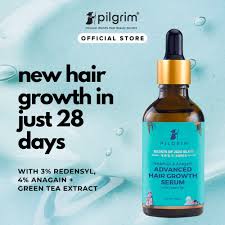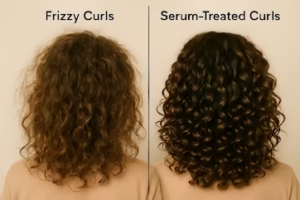Ever stood in the hair care aisle, staring at rows of hair serums, wondering, “Which one is right for me?” You’re not alone. With countless options promising frizz-free, glossy, smooth, and strong hair, choosing the right serum can feel like decoding a secret language.
But don’t worry—you don’t need to be a chemist or a stylist to figure it out. In this blog, we’ll break down how to choose the perfect hair serum based on your hair type, concerns, and ingredients. Let’s make your next serum purchase an informed (and rewarding) one!
1. Start with Your Hair Type

Before even touching a bottle, get clear about your hair type. Is it fine and straight? Thick and curly? Oily or dry? Each hair type responds differently to certain ingredients and textures.
- Fine Hair: Needs lightweight serums that won’t weigh it down.
- Thick or Coarse Hair: Benefits from heavier, nourishing serums.
- Curly Hair: Craves moisture and definition.
- Oily Hair: Does better with water-based or silicone-free serums.
- Dry Hair: Needs intense hydration—think oils and butters.
Understanding your hair type is the foundation for finding a serum that works with your strands, not against them.
2. Consider Your Main Hair Concern
Now ask yourself—what’s your main hair issue?
- Is your hair frizzy and unmanageable?
- Are you dealing with hair fall or thinning?
- Is your hair dry, damaged, or chemically treated?
- Do you want more shine and softness?
- Is your scalp sensitive or irritated easily?
Once you identify your concern, the process becomes much simpler. You’re no longer looking at 50 different serums. You’re hunting for the one that solves your problem.
3. Look at the Ingredients Like a Pro
Let’s get real for a second—ingredients matter. Hair serum isn’t just a glossy liquid; it’s a formula made up of active ingredients that deliver specific results. Here’s a breakdown:
For Frizz and Shine:
- Silicones like dimethicone or cyclopentasiloxane coat the hair, seal moisture, and reduce frizz.
- Argan Oil and Jojoba Oil add smoothness and gloss without greasiness.
For Hair Fall or Breakage:
- Redensyl, Procapil, and Peptides support follicle health and minimize breakage.
- Biotin strengthens weak strands over time.
For Dry or Damaged Hair:
- Keratin, Panthenol (Vitamin B5), and Hydrolyzed Proteins repair the hair shaft and restore elasticity.
For Scalp Care:
- Niacinamide soothes the scalp.
- Tea Tree Oil or Salicylic Acid (in scalp serums) help clarify and balance oil production.
Be ingredient-aware and always read labels. If the “hero” ingredient is way down the list, it’s probably not doing much.
4. Match the Texture to Your Hair
Yes, texture matters. Just like how you wouldn’t wear a heavy winter jacket on a hot day, you don’t want a greasy serum if your hair is already oily.
- Lightweight, watery serums: Great for fine or oily hair.
- Creamy or oil-rich serums: Better for dry, coarse, or curly hair.
- Gel-based serums: Ideal for styling or anti-frizz control without weighing down hair.
You want something that absorbs into your hair, not sits on top of it.
5. Don’t Ignore Your Scalp
Many people forget that the scalp is part of the hair care equation. If your serum touches the roots (some do!), make sure it’s designed for scalp use.
- Scalp serums target hair growth, irritation, or oil balance.
- Regular styling serums should only go on mid-lengths and ends to avoid clogging pores.
If you’ve got a sensitive scalp, stick to alcohol-free, fragrance-free, and paraben-free formulas.
6. Patch Testing Is a Must
This step is often skipped but can save you a lot of regret. Before slathering serum all over your hair, do a quick patch test behind your ear or on a small section of your scalp.
- No itching? No redness? You’re good to go!
- Any stinging, flaking, or irritation? That serum’s not for you.
This is especially important if you’re trying a serum with strong actives like Redensyl or botanical extracts.
7. Think About Your Routine
Ask yourself: “When and how do I want to use this?”
- Daily styling: Go for lightweight, fast-absorbing serums that add shine or smoothness.
- Pre-heat styling: Look for serums with heat protectant properties.
- Overnight or deep treatments: Use heavier, nourishing serums with oils and proteins.
- Hair growth: Choose scalp serums with targeted actives and use them at night for best absorption.
The more you tailor your serum to your routine, the better results you’ll get.
8. Learn From Reviews—But With a Grain of Salt
Customer reviews can be helpful, but remember: hair is personal. What works wonders for one person might flop for another. Look for reviews from people with a similar hair type and concern.
Pro tip: Look for photos in reviews or testimonials from real users, especially for new or unfamiliar brands.
Final Thoughts: Trust Your Hair & Keep It Simple
Choosing a hair serum isn’t rocket science, but it does take some thought. Start by knowing your hair type, identifying your top concern, and getting friendly with ingredients. Once you do, you’ll be able to pick the perfect serum like a pro.
Don’t fall for shiny packaging or over-the-top promises. The best serum is the one that works for your hair, not the one with the most buzz.
Oh—and remember to give your hair time to respond. Most serums take 2–4 weeks of consistent use to show real results. Be patient, be observant, and don’t be afraid to switch it up if something’s not working.
Happy serum shopping—and here’s to your best hair days ahead!
check out our best picks
- Best hair serum in 2025
- Best hair serum for Men



